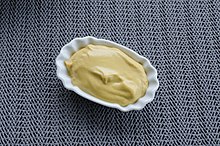
Back Mosterd Afrikaans Senabe AN صلصة الخردل Arabic مسترده ARZ Mostaza AST Semf BAR Гарчыца Byelorussian Mustardi BEW Горчица Bulgarian Senf BS
 Mustard in a dish | |
| Course | Condiment |
|---|---|
| Region or state | Worldwide distribution |
| Main ingredients | Mustard seed, water, vinegar, salt |

Mustard is a condiment made from the seeds of a mustard plant (white/yellow mustard, Sinapis alba; brown mustard, Brassica juncea; or black mustard, Brassica nigra).
The whole, ground, cracked, or bruised mustard seeds are mixed with water, vinegar, lemon juice, wine, or other liquids, salt, and often other flavorings and spices, to create a paste or sauce ranging in color from bright yellow to dark brown. The seed itself has a strong, pungent, and somewhat bitter taste. The taste of mustard condiments ranges from sweet to spicy.
Mustard is commonly paired with meats, vegetables and cheeses, especially as a condiment for sandwiches, hamburgers, and hot dogs. It is also used as an ingredient in many dressings, glazes, sauces, soups, relishes, and marinades. As a paste or as individual seeds, mustard is used as a condiment in the cuisine of India and Bangladesh, the Mediterranean, northern and southeastern Europe, Asia, the Americas, and Africa,[1] making it one of the most popular and widely used spices and condiments in the world.[2]
- ^ Hazen, p. 13
- ^ García-Casal, Maria Nieves; Peña-Rosas, Juan Pablo; Malavé, Heber Gómez- (2016). "Sauces, spices, and condiments: definitions, potential benefits, consumption patterns, and global markets". Annals of the New York Academy of Sciences. 1379 (1): 3–16. Bibcode:2016NYASA1379....3G. doi:10.1111/nyas.13045. PMID 27153401. S2CID 13782295.